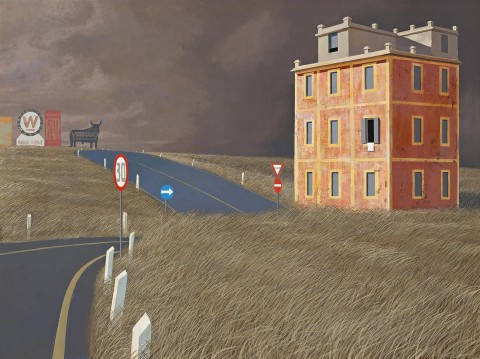FIUMICINO BYPASS, 1966
JEFFREY SMART
oil on canvas
58.5 x 76.5 cm
signed and dated lower right: JEFFREY SMART 66
inscribed with title verso: FIUMICINO BYPASS
South Yarra Gallery, Melbourne
The Osborne Art Gallery, Adelaide
Artarmon Gallery (Artlovers), Sydney (label attached verso)
Artbank, Sydney
Jeffrey Smart, South Yarra Gallery, Melbourne, 19 April 1966, cat. 17 (as ‘Fiumincina [sic] Bypass’)
McCulloch, A., ‘Perfection in Paint’, Herald, Melbourne, April 1966
Quartermaine, P., Jeffrey Smart, Gryphon Books, Melbourne, 1983, cat. 475, p. 110
Jeffrey Smart, the inveterate traveller, invariably filled his paintings with images of and allusions to movement – trucks, autostrada, road signs – all attired in the paradox of stillness. Smart had returned to Europe in 1964, living in Rome before embarking on his many travels the following year, which were to become annual affairs. In April 1965, he held his first solo exhibition in Italy at Rome’s Galleria 88, before leaving for Paris and a lengthy stay in Spain. When he exhibited Fiumicino Bypass, 1966 in his show at Melbourne’s South Yarra Gallery in April the following year, he included paintings from many diverse locations – Madrid Airport, The Steps, Parma and Antibes. As Rome’s international airport is at Fiumicino, the bypass in our painting perhaps suggests his return home, cautioned by the ‘30’ speed sign with care in handling the sharp bend in the road and what lay beyond the precipitous horizon ahead. Curiously, it is challenged by a confrontational bull bearing the words ‘COGNAC/VETERANO/OSBORNE’, the logo for a much-admired Spanish brandy. Other billboards variously worded – ‘Westinghouse Radio Borne’ broadcasting around the world – maintain the international touch. Characteristically, each offers its own tantalising riddle, with the ubiquitous arrow pointing to a stop sign.
Fiumicino Bypass, 1966 is classic Smart. Realism, flirting with the intrigue of surrealism, is spiced with the enigmatic and a marvellous sense of the theatrical, especially through the dramatic use of light. The sky is filled with a strange light of expectation. The isolation is spellbinding. Its building was a favourite, appearing, with variations, in several of Smart’s works of the time. In a note to his watercolour, The Owner, 1964 – 65 (private collection), Smart noted: ‘The building is still standing in a sort of wasteland between Roma and EUR, on the main road. It was also used for Outskirts, Athens, 1965 …, and various other works’.1 The early significance of the building for Smart is confirmed by a haunting familiarity in Self Portrait, 1964 – 65 (private collection) – window shutters open, revealing nothing but darkness. Our painting is rich in such Smart features which have become favourites over time. His fascination with the curves and sweep of roads had an early blossoming in Approaching Storm by Railway, 1955 (private collection), reaching an early peak in the masterly The Cahill Expressway, 1962 (National Gallery of Victoria, Melbourne). The fields of grass, blown by a wind while all else remains still, frequent other paintings such as The Listeners of 1965 (Art Gallery of Ballarat, Victoria) or later The Dome, 1977 (TarraWarra Museum of Art, Victoria). For the ever articulate Smart, all is redolent with the sounds of silence, so in keeping with its time.2 And finally there is Smart’s singular mastery of composition based on his own concept of perfection achieved through what he called ‘crystallisation’: ‘That’s how I work – by crystallising emotion’.3 The mid sixties were vintage years for Smart, highlighted in his South Yarra exhibition of 1966 in which Fiumicino Bypass was joined by the already mentioned Antibes, 1965 in the collection of the National Gallery of Australia, Canberra, and The Listeners, 1965, in Blair Ritchie’s bequest to the Art Gallery of Ballarat.
1. See Jeffrey Smart: Drawings and Studies 1942-2001, Australian Galleries, Melbourne, 2001, with commentary by Smart, pp.74, 70.
2. Paul Simon wrote the song ‘The Sounds of Silence’ in 1964. When rereleased by Simon and Garfunkel in late 1965, it became an international hit.
3. Smart, J., referring to Madrid Airport, 1965 in Capon, E., Jeffrey Smart Retrospective, Art Gallery of New South Wales, Sydney, 1999, p. 103
DAVID THOMAS
